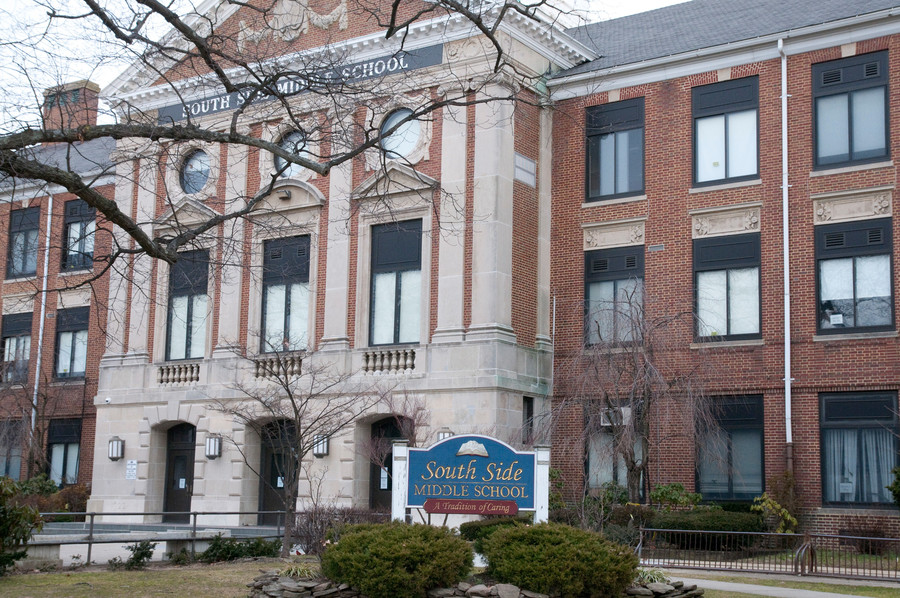South Side Middle School student art stirs debate
Questions arise over display of works featuring swastikas
The display of two pieces of student art that incorporate swastikas has sparked controversy at South Side Middle School, as well as promises from the administration that it will never happen again.
The artworks hung in the halls of the school for about three weeks before they were brought to the attention of the Board of Education at its meeting on May 25. The next day, Principal Shelagh McGinn had the pieces removed.
They were produced as part of the eighth-grade Studio Art class’s study of German Expressionism and degenerate art, which coincided with units about World War II and the Holocaust in English Language Arts and social studies classes. One piece was a portrait of a German soldier wearing a gas mask and with a swastika tattooed on his chest. The other depicted demons, one with a swastika on it.
According to McGinn, the intent of the student artists was to vilify Nazis and show how scary and evil they were. There was no glorification of Nazism or the swastika.
“The kids drew these, but not out of a place of hate,” said school board President Liz Dion.
Word of the drawings spread after the May board meeting, and many parents came to the meeting on June 21 to voice their worry and anger about the artworks’ display.
“A swastika hanging up in the school, which is something that would be seen by lots of people, is something that is offensive to lots of people here,” said Jeff Daitch. “Whether you’re Jewish or not. Somebody should have caught this.”
Both McGinn and Superintendent Dr. William Johnson apologized to the parents several times for not realizing that the pieces were hanging in the school. “We’re not an art gallery, we’re a middle school,” Johnson said. “It’s a public place where both children and adults have an opportunity to walk those halls and observe, and it should not have been there. We recognize, acknowledge and understand that it should not have been there. I think we’ve taken appropriate action so that will not happen again. It’s not going to happen.”
Art teachers will now look more closely at students’ work, and McGinn will inspect all works that may hang in the school’s halls.
McGinn also said that she would be reviewing the curriculum with her staff to see what may have led to the students’ artistic interpretations, and to make sure that lessons are there to reinforce what Nazism was and the hate the swastika has come to symbolize. “We’re always reviewing and revamping, and [the teachers] already have ideas of some of the changes of what they want to do,” she said.
Ray Fishler, a longtime Rockville Centre resident and a Holocaust survivor, said he was surprised when he heard about the artwork. “I was very much shocked when I heard that this happened in the middle school,” he said. “Because I do know how much effort the teachers of the middle school are putting in to keep the memory of the Holocaust alive, and to teach the children [about] the past to prevent the past from happening again.”
Fishler, who speaks to eighth-graders every year about his experience, said the district was absolutely right to take down the artwork. “There’s no question in my mind,” he said. “It should be prevented from happening.”
One community member who was not entirely opposed to the pieces’ display was Rabbi Marc Gruber, the spiritual leader of Central Synagogue. “I think the mistake was a lack of context,” he said. “I don’t think the mistake was necessarily hanging it, but where it was hung. And without any contextual reference. If it was in the studio where the eighth-graders were, it would have been different.”
Gruber said that the pieces should have been accompanied by a description of degenerate art to give them more context — although both he and McGinn acknowledged that students would be unlikely to read it. The term was used by the Nazis to describe virtually all modern art, but some artists used swastikas in their work to mock the regime.
“It happens that in March, I was in Jerusalem at the Israel Museum and attended an exhibit on degenerate art,” Gruber said. “And it happened that there are plenty of late ‘degenerate’ artists who use swastikas in their work as protests against the Nazis.
“I got the student who was portraying the Nazis as demons right away,” he added.
Parents questioned how so many people could walk by the pieces for three weeks and not notice them. McGinn responded that teachers did notice them, and spoke to the student artists about them, and the students explained their message.
Dion said that neither the students nor the teachers were disciplined for hanging the pieces.
“The bottom line is, we made a mistake,” said Johnson. “It should never have happened. Or, if it did go up, it should have gone up in a contextual situation where it was clearly articulated what the intent of the artist was. That being said, I just don’t believe that, at least in the middle school, it belongs on any of our walls anywhere.”

 49.0°,
Fair
49.0°,
Fair 





